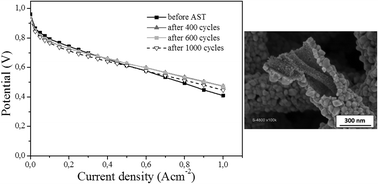Negligible degradation upon in situ voltage cycling of a PEMFC using an electrospun niobium-doped tin oxide supported Pt cathode
Abstract
Novel platinum-catalysed, corrosion-resistant, loose-tube-structured electrocatalysts for proton exchange membrane fuel cells have been obtained using single-needle electrospinning associated with a microwave-assisted polyol method. Monodisperse platinum particles supported on Nb–SnO2 demonstrated higher electrochemical stability than conventional Pt/C electrodes during ex situ potential cycling and comparable activity in the oxygen reduction reaction. In situ fuel cell operation under accelerated stress test conditions of a membrane electrode assembly elaborated using a Pt/C anode and Pt/Nb–SnO2 cathode confirmed that the voltage loss is significantly lower for the novel cathode than for an MEA prepared using conventional Pt/C supported electrocatalysts. Furthermore, the Nb–SnO2 stabilised the supported platinum nanoparticles against dissolution, migration and reprecipitation in the membrane. Pt/Nb–SnO2 loose-tubes constitute a mitigation strategy for two known degradation mechanisms in PEMFC: corrosion of the carbon support at the cathode, and dissolution of Pt at high cell voltages.


 Please wait while we load your content...
Please wait while we load your content...